This article was published in Scientific American’s former blog network and reflects the views of the author, not necessarily those of Scientific American
Today (September 24th, 2016) is World Cassowary Day. This time, I’ve just about been paying attention, so here are some thoughts. Regular readers will know that I have a special attachment to palaeognaths (the group of birds that includes the flightless ratites and the flight-capable tinamous) and have a special research interest in cassowaries in particular.
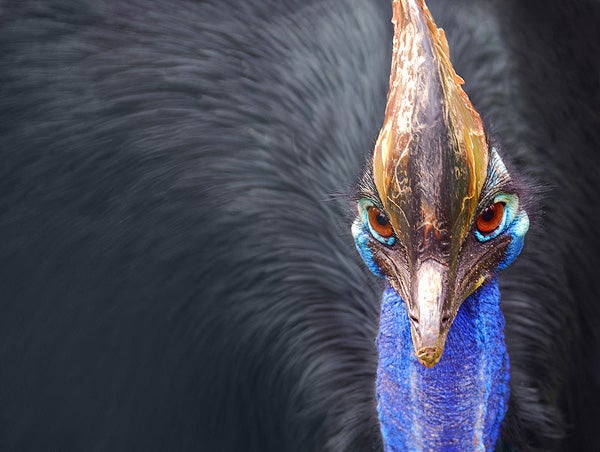
Southern or Double-wattled cassowary, most familiar of the species by far. Credit: PAUL IJSENDOORN Flickr(CC BY 2.0)
Cassowaries are fascinating birds in their own right that play a crucial role in the function and maintenance of their communities, but they’re also of special interest because several aspects of their biology, behaviour and anatomy might be applicable to a range of weird extinct archosaurs – the irony being that we know about as much about living cassowaries as we do about the long-extinct animals I have in mind…
On supporting science journalism
If you're enjoying this article, consider supporting our award-winning journalism by subscribing. By purchasing a subscription you are helping to ensure the future of impactful stories about the discoveries and ideas shaping our world today.
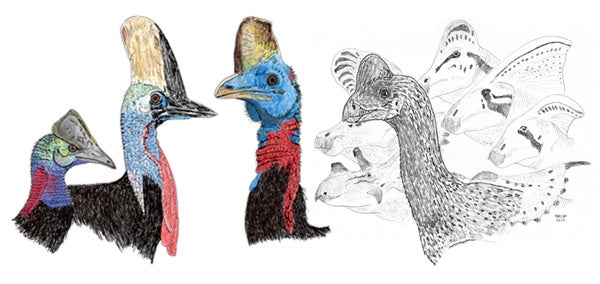
If we knew more about the evolution and function of the cassowary casque, would we better understand the superficially similar structures present in some extinct dinosaurs (like the oviraptorosaur and assorted ornithischians shown here)? It's an interesting idea. Credit: Darren Naish
Anyway, the basic facts about cassowaries are probably already well known to you. These are large, shaggy-feathered, mostly black, forest-dwelling relatives of emus noted for their tall, keratinous head crests, brightly coloured, naked-skinned faces, necks and wattles and enlarged, spike-like digit II claws (digit I is absent, but the innermost of the three toes still counts as digit II). The three or four extant species mostly occur on New Guinea but one (the Southern or Double-wattled cassowary Casuarius casuarius) also occurs in north-eastern Australia.
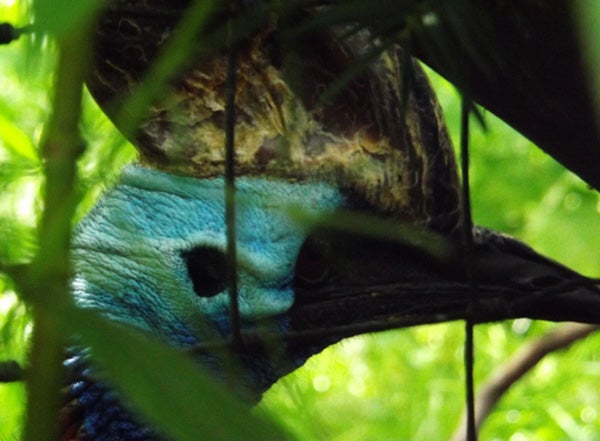
Captive Southern cassowary at Edinburgh Zoo, UK, showing details of head skin (fuzzy, not really naked) and casque surface. Credit: Darren Naish
The Southern cassowary is what we call a keystone species: it plays a critical role in maintaining the ecology of its environment, mostly due to its consumption and dispersal of fruits and seeds. The same is probably true of the other cassowaries too, the problem being that their ecology and behaviour is substantially under-studied. Do see Andrew Mack’s book Searching for PekPek: Cassowaries and Conservation in the New Guinea Rainforest (Mack 2014) for much more on these issues.
Cassowaries don’t just inhabit Australia and New Guinea. They also occur on various of the surrounding small islands, though working out the details of their distribution and biogeographical history is made difficult by the fact that they’ve been used as tributes and trade items for centuries. The Chinese were receiving cassowaries in trade during the 14th century and a bird thought to have originated on Ceram in the Moluccas (though note that this has never been confirmed) was shipped (live) to Amsterdam – after being obtained on Java – in 1597 (Perron 2016). A model of cassowary evolution and history was recently published by Richard Perron and myself (Naish & Perron 2014).
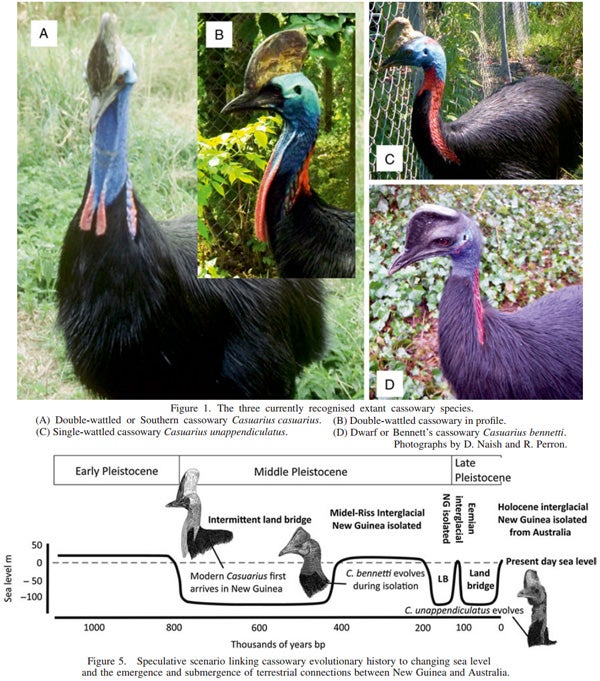
The extant cassowaries, and a tentative model of their evolution and dispersal to New Guinea, from Naish & Perron (2014). Credit: Naish & Perron 2014
Today, cassowaries – ugh, like so many animals and other living things right now – need our help. Cassowary habitat on the Australian mainland has been, and is being, carved up into ever-smaller pockets thanks to development and building and about 80% of it has gone, small-scale clearing and urban development continuing to be a problem. There are now efforts to buy up remaining habitat blocks and link them via the creation of habitat corridors. Additional problems obviously linked with development and road building concern death following vehicle collisions, and death or injury resulting from domestic dog interaction. The numbers are not pretty, about 12 birds being killed annually on roads. The message does seem to be getting out that fast-moving traffic in regions where wild cassowaries occur poses a real and constant problem to these animals, with traffic-calming measures and increased signage helping improve awareness.
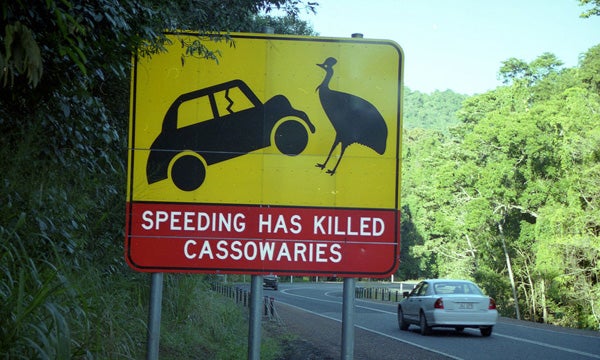
Famous cassowary-themed road sign in Cairns, Queensland. Credit: I LOVE TREES Wikimedia(CC BY 2.0)
Cassowary decline is made all the more disturbing given how little we actually know about these birds. Many ideas on their ecology, behaviour and biology are horrendously under-studied. Even one of the most basic questions in biology – how many taxa there are – is unresolved and in need of resolution.
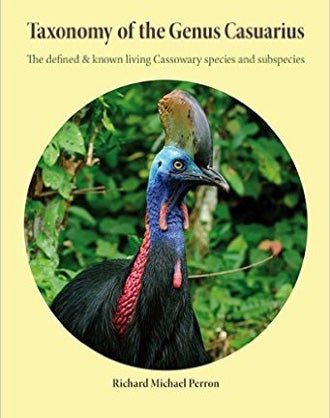
Cover of Perron (2016). Credit: SPECIES AND SUBSPECIES PERRON 2016
On that note, my colleague Richard Perron has recently published the book Taxonomy of the Genus Casuarius: the Defined and Known Living Cassowary Species and Subspecies (Perron 2016), a useful and well illustrated catalogue of the cassowaries named so far. There are a lot more than you might have realised, many of which are of unresolved status. I won’t discuss Richard’s conclusions (you should purchase the book if you’re that interested), but I will mention Casuarius roseigularis, an allegedly new cassowary species named by Walter Rothschild in 1905 for a bird with a unique bright pink and yellow head and neck. It only lived for three days at the Zoological Society of London and “might have died from having been painted by the dealer”! (Perron 2016, p. 58).
Anyway: have a good World Cassowary Day 2016, and let’s hope that increased awareness and appreciation of these birds might help ensure their persistence, and that of the habitats they occupy, into future decades.
Cassowaries have been covered here on a few previous occasions. See…
Walter Rothschild and the rise and fall of Sclater’s cassowary
Controversies from the world of ratite and tinamou evolution (part I)
Refs - -